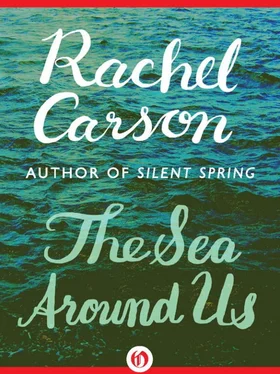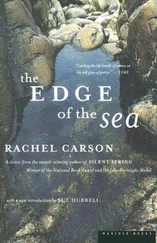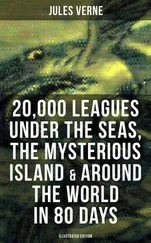Even then, the evidence was accumulating. Sir John Ross, during his exploration of the arctic seas in 1818, had brought up from a depth of 1000 fathoms mud in which there were worms, ‘thus proving there was animal life in the bed of the ocean notwithstanding the darkness, stillness, silence, and immense pressure produced by more than a mile of superincumbent water.’
Then from the surveying ship Bulldog, examining a proposed northern route for a cable from Faroe to Labrador in 1860, came another report. The Bulldog’s sounding line, which at one place had been allowed to lie for some time on the bottom at a depth of 1260 fathoms, came up with 13 starfish clinging to it. Through these starfish, the ship’s naturalist wrote, ‘the deep has sent forth the long coveted message.’ But not all the zoologists of the day were prepared to accept the message. Some doubters asserted that the starfish had ‘convulsively embraced’ the line somewhere on the way back to the surface.
In the same year, 1860, a cable in the Mediterranean was raised for repairs from a depth of 1200 fathoms. It was found to be heavily encrusted with corals and other sessile animals that had attached themselves at an early stage of development and grown to maturity over a period of months or years. There was not the slightest chance that they had become entangled in the cable as it was being raised to the surface.
Then the Challenger, the first ship ever equipped for oceanographic exploration, set out from England in the year 1872 and traced a course around the globe. From bottoms lying under miles of water, from silent deeps carpeted with red clay ooze, and from all the lightless intermediate depths, net-haul after net-haul of strange and fantastic creatures came up and were spilled out on the decks. Poring over the weird beings thus brought up for the first time into the light of day, beings no man had ever seen before, the Challenger scientists realized that life existed even on the deepest floor of the abyss.
The recent discovery that a living cloud of some unknown creatures is spread over much of the ocean at a depth of several hundred fathoms below the surface is the most exciting thing that has been learned about the ocean for many years.
When, during the first quarter of the twentieth century, echo sounding was developed to allow ships while under way to record the depth of the bottom, probably no one suspected that it would also provide a means of learning something about deepsea life. But operators of the new instruments soon discovered that the sound waves, directed downward from the ship like a beam of light, were reflected back from any solid object they met. Answering echoes were returned from intermediate depths, presumably from schools of fish, whales, or submarines; then a second echo was received from the bottom.
These facts were so well established by the late 1930’s that fishermen had begun to talk about using their fathometers to search for schools of herring. Then the war brought the whole subject under strict security regulations, and little more was heard about it. In 1946, however, the United States Navy issued a significant bulletin. It was reported that several scientists, working with sonic equipment in deep water off the California coast, had discovered a widespread ‘layer’ of some sort, which gave back an answering echo to the sound waves. This reflecting layer, seemingly suspended between the surface and the floor of the Pacific, was found over an area 300 miles wide. It lay from 1000 to 1500 feet below the surface. The discovery was made by three scientists, C. F. Eyring, R. J. Christensen, and R. W. Raitt, aboard the U.S.S. Jasper in 1942, and for a time this mysterious phenomenon, of wholly unknown nature, was called the ECR layer. Then in 1945 Martin W. Johnson, marine biologist of the Scripps Institution of Oceanography, made a further discovery which gave the first clue to the nature of the layer. Working aboard the vessel E. W. Scripps, Johnson found that whatever sent back the echoes moved upward and downward in rhythmic fashion, being found near the surface at night, in deep water during the day. This discovery disposed of speculations that the reflections came from something inanimate, perhaps a mere physical discontinuity in the water, and showed that the layer is composed of living creatures capable of controlled movement.
From this time on, discoveries about the sea’s ‘phantom bottom’ came rapidly. With widespread use of echo-sounding instruments, it has become clear that the phenomenon is not something peculiar to the coast of California alone. It occurs almost universally in the deep ocean basins—drifting by day at a depth of several hundred fathoms, at night rising to the surface, and again, before sunrise, sinking into the depths.
On the passage of the U.S.S. Henderson from San Diego to the Antarctic in 1947, the reflecting layer was detected during the greater part of each day, at depths varying from 150 to 450 fathoms, and on a later run from San Diego to Yokosuka, Japan, the Henderson’s fathometer again recorded the layer every day, suggesting that it exists almost continuously across the Pacific.
During July and August 1947, the U.S.S. Nereus made a continuous fathogram from Pearl Harbor to the Arctic and found the scattering layer over all deep waters along this course. It did not develop, however, in the shallow Bering and Chuckchee seas. Sometimes in the morning, the Nereus fathogram showed two layers, responding in different ways to the growing illumination of the water; both descended into deep water, but there was an interval of twenty minutes between the two descents.
Despite attempts to sample it or photograph it, no one is sure what the layer is, although the discovery may be made any day. There are three principal theories, each of which has its group of supporters. According to these theories, the sea’s phantom bottom may consist of small planktonic shrimps, of fishes, or of squids.
As for the plankton theory, one of the most convincing arguments is the well-known fact that many plankton creatures make regular vertical migrations of hundreds of feet, rising toward the surface at night, sinking down below the zone of light penetration very early in the morning. This is, of course, exactly the behavior of the scattering layer. Whatever composes it is apparently strongly repelled by sunlight. The creatures of the layer seem almost to be held prisoner at the end—or beyond the end—of the sun’s rays throughout the hours of daylight, waiting only for the welcome return of darkness to hurry upward into the surface waters. But what is the power that repels; and what the attraction that draws them surfaceward once the inhibiting force is removed? Is it comparative safety from enemies that makes them seek darkness? Is it more abundant food near the surface that lures them back under cover of night?
Those who say that fish are the reflectors of the sound waves usually account for the vertical migrations of the layer by suggesting that the fish are feeding on planktonic shrimp and are following their food. They believe that the air bladder of a fish is, of all structures concerned, most likely from its construction to return a strong echo. There is one understanding difficulty in the way of accepting this theory: we have no other evidence that concentrations of fish are universally present in the oceans. In fact, almost everything else we know suggests that the really dense populations of fish live over the continental shelves or in certain very definitely determined zones of the open ocean where food is particularly abundant. If the reflecting layer is eventually proved to be composed of fish, the prevailing views of fish distribution will have to be radically revised.
Читать дальше












